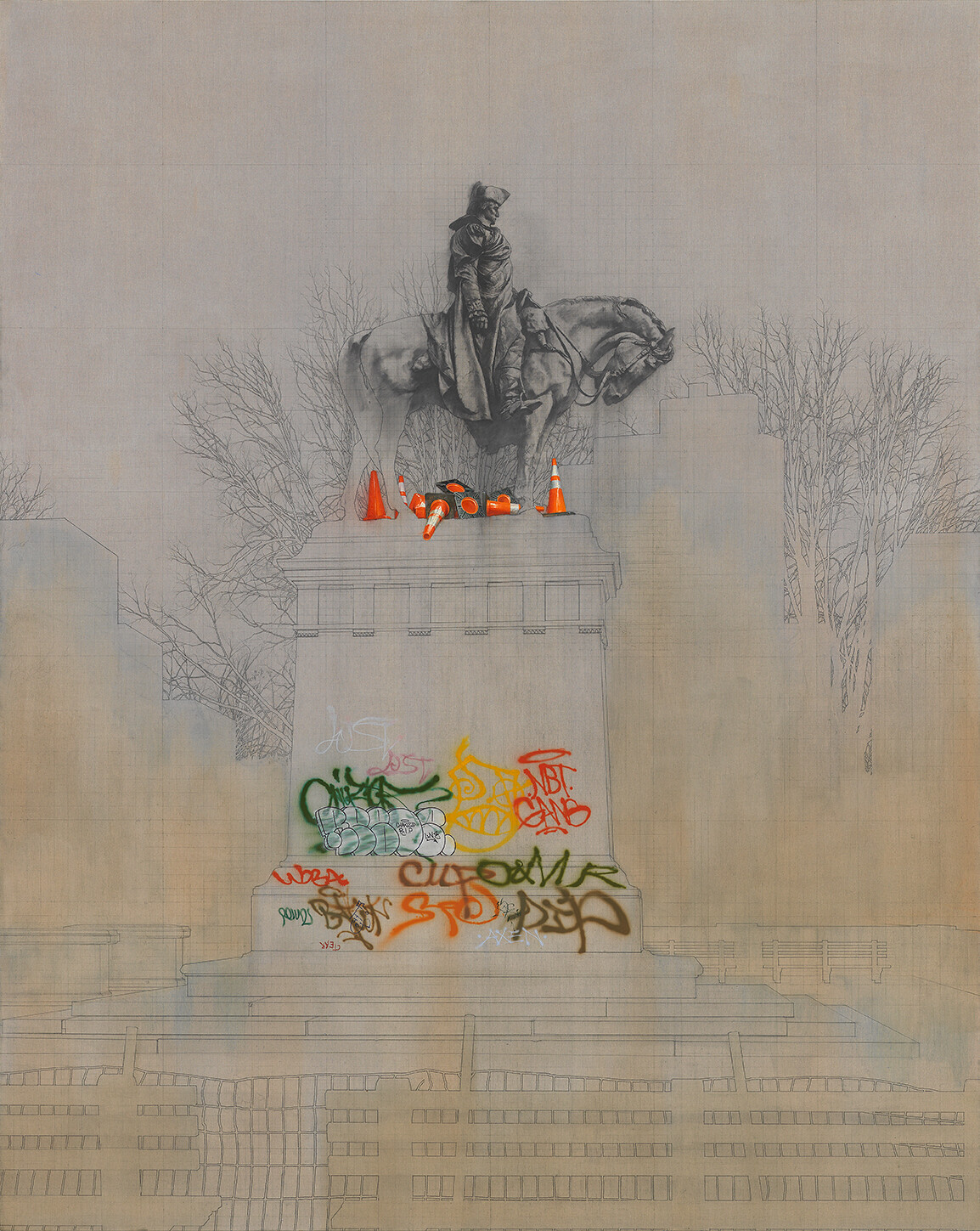Karrabing Film Collective: Night Fishing with Ancestors
October 7, 2023–January 14, 2024
St James'
London SE14 6AD
United Kingdom
Hours: Wednesday–Sunday 12–6pm
T +44 20 8228 5969
goldsmithscca@gold.ac.uk
Goldsmiths CCA will host the first UK institutional exhibition by artist Esteban Jefferson, October 7, 2023–January 14, 2024. Jefferson’s practice critiques legacies of colonialism and racism as encoded in museum displays and public artworks. He will create a new series of works for the exhibition revolving around the detritus from public displays of protest related to the death of George Floyd. Through repeated visits to sites of protest, from small interventions like graffiti on a bus stop sign to large-scale vandalism of well-known colonialist monuments, Jefferson tracks the lifespan of the protests that erupted in 2020.
Additional works in the show depict the Theodore Roosevelt Memorial statue that was positioned outside the American Museum of Natural History in New York until 2022. The statue features Roosevelt on horseback, flanked on each side by a Native American and Black man at his feet. The statue had been the focus of a sustained campaign of criticism for years and was finally removed, but not destroyed, in January 2022. The sculpture has since been relocated to the Theodore Roosevelt Presidential Library in North Dakota (out of sight, out of mind).
In previous exhibitions, Jefferson’s work has further examined the representation of marginalized figures in museum settings, through paintings and sculptural objects. The series “Petit Palais” (2019-2021) revolved around two Venetian busts of Black subjects which sit behind the reception desk of the Petit Palais Fine Arts Museum of Paris. In the paintings, the museum itself is rendered as a ghostly sketched presence, while the two busts are intricately detailed, bringing them into the foreground of the picture plane while they remain backgrounded in reality through the curatorial choices of the museum. This choice in depiction creates a laser-like focus and elevation of the neglected works, who are not recorded in the museum’s wall texts or the catalogue as anything more than “Buste d’Africaine.”
Esteban Jefferson (b. 1989, New York) is an artist based in New York. Solo shows include 303 Gallery, New York (2023); Tanya Leighton, Los Angeles (2021); Tanya Leighton, Berlin (2020), and White Columns, New York (2019). Group shows include Fire Figure Fantasy, ICA, Miami; Open Call, The Shed, New York; ESTAMOS BIEN, La Trienal, Museo del Barrio; New York, Art on the Grid, Public Art Fund, New York.
Goldsmiths CCA will also present an exhibition of films by the Karrabing Film Collective, a grassroots Indigenous media group of approximately 30 members living in the Belyuen Community, in Australia’s Northern Territory. The exhibition comprises existing works, and a new film, Night Fishing with Ancestors (2023), which will be seen for the first time in the UK.
Connecting the four films on display is the concept of theft; both of the traumatic historical theft of land and children, but also an ongoing theft of a future through environmental degradation. The exhibition proposes an ultimate connectedness between the specificity of the Karrabing experience and the wider global population, under a climate emergency that has been underwritten by extractive capitalism and settler colonialism.
Night Fishing with Ancestors follows the story of the Macassan traders who, from around 1700, sailed to the Australian coast from Indonesia, to collect trepang (sea cucumbers); a moment of contact between Asia and Indigenous people from Australia that predates European settlement, and that was peaceful and collaborative. This provides a model of contact that undermines the violence of white colonialism. White settlers make an incursion in the film through the figure of the zombie, a reoccurring presence in recent Karrabing films as “life turned to Nonlife and transformed into a new kind of species war” (Elizabeth Povinelli, Issue 81, e-flux journal, 2017).
Karrabing use filmmaking as a counter-practice through which to explore shared histories that have been suppressed and partially erased, to forge intergenerational relationships across the group, to reconnect to the land, and, through the international art world, to attract funds to support access to their lands. Karrabing was formed in the aftermath of settler governance that had forced them from their lands in 2007, and initially films were made using the techniques of formal filmmaking. Later films are self-shot on phones, and use layered editing techniques to relate contemporary stories – such as a boat breaking down or cops interfering in daily life – whilst also interweaving ancestral relationships and traditional narratives. The films have multiple entry points, through a hallucinatory quality, keen sense of humour, reference to genre films (such as zombie movies), whilst also excavating knowledge of the complex mythologies that root the Karrabing to their ancestors.
Karrabing Film Collective (est. 2012, Australia) is a grassroots Indigenous media group consisting of over thirty members. They approach filmmaking as a mode of self-organisation and a means of investigating contemporary social conditions of inequality. Screenings and publications allow the Karrabing to develop a local artistic language and allow audiences to understand new forms of collective Indigenous agency. Their films represent their lives, create bonds with their land and intervene in global images of Indigeneity. Their films and installations have been exhibited at MoMA-PS1, New York; Secession, Vienna; Haus der Kunst Munich, Contour Biennale, Mechelen, Belgium; Berlinale Forum Expanded; Hallucinations, Athens at documenta 14; Sydney Biennale; vdrome.org; e-flux supercommunity at the Venice Biennale; Doc’s Kingdom, Lisbon; and Wexner Center for the Arts, Columbus, Ohio, among others. They are the recipients of the Visible Award (2015), Eye Film Prize, Eye Filmmuseum (2022) amongst others.

